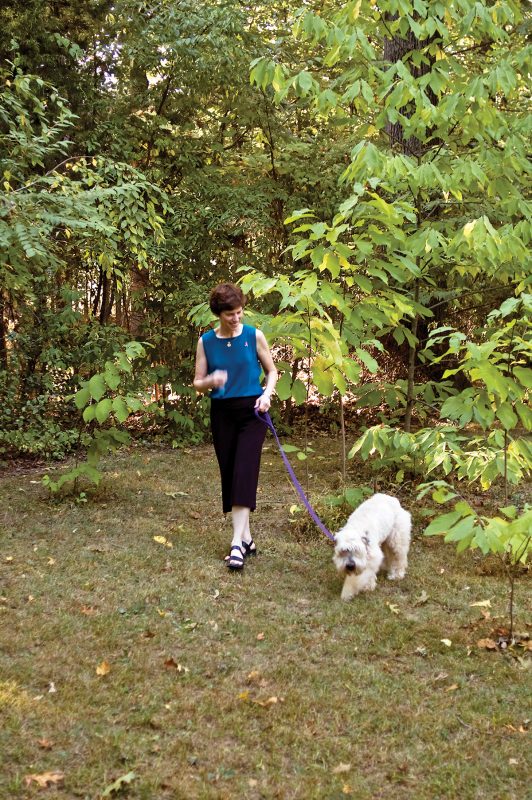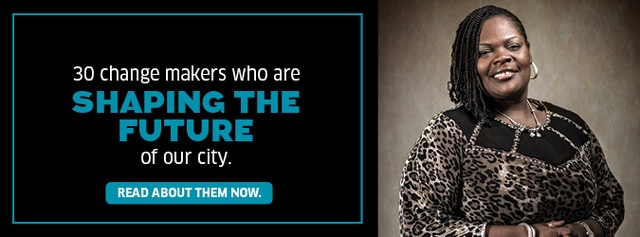Health & Wellness
When Doctors Get Sick
What happens when physicians fall ill? Here are three local doctors who ended up on the other side of the examination table.

Thomas Smyth, M.D. habitually fiddles with his wedding ring. But
one day this July, the 48-year-old urologist with Chesapeake Urology
Associates, P.A. realized he couldn’t get the ring off his finger. He
also felt weaker and more tired than he should, and so he thought he
might have injured a cervical disk; he scheduled an MRI for the next
day. At home that night, his weakness and fatigue continued. He
couldn’t walk the dog for longer than a few minutes, and he posited to
his wife Tina that perhaps he had Lyme disease. By the next day, things
had taken a turn for the worse.
“I got up the next morning, and my thighs burned when [my feet] hit
the floor,” he recalls. “I got in the shower, and the soap literally
just fell from my hands, and I had the feeling that, if I reached down
to get it, I would fall. I woke Tina up and said, ‘Something’s really
wrong.'”
Smyth went to the emergency room at St. Joseph’s Medical Center at
about 6:30 a.m., and his wife returned home to care for their three
young sons. At the ER, the weakness in his arms and legs worsened. “I
was very concerned that it was a tumor—a brain tumor or a spinal cord
tumor,” he says. “I was petrified of that.” However, an MRI showed no
tumor. Yet by 11:30 a.m., he was unable to walk.
Eventually, the culprit was discovered: Smyth was diagnosed with
Guillain-Barre Syndrome, a rare disorder in which the body’s immune
system attacks part of the peripheral nervous system. While most
patients do recover from the illness, it can cause almost complete
paralysis before it improves, and there is a danger that the paralysis
can affect the body’s ability to function before recovery can begin. By
midnight, Smyth was completely paralyzed as he lay in the intensive
care unit, receiving immunoglobulin treatments.
According to Smyth, the first 12 hours was the hardest. “I wanted to
be in control,” he says. “Not in a mean way, but I wanted to know what
was going on, and I hated waiting for people to come to tell me
information.” Late that first night, he had what he calls his “come to
Jesus” moment—a span of time when he relied on his spirituality to help
him let go of his need to control his own care. He made himself do what
he tells his patients to do, and trust that his caregivers were giving
him the best care possible.
There is an old stereotype that doctors don’t get sick—and there’s a
related saying that, when doctors do get sick, they make the worst
patients. Doctors are supposed to be infallible, unbreakable—bastions
of health who aren’t supposed to fall prey to illness like the average
person.
When a doctor does become sick, it creates a complicated situation
for not only the physician patient, but for the physician treating the
doctor, and the patients that the sick doctor oversees.
“Doctors are used to being in control, and relinquishing that role is
very, very difficult,” says Mark Ehrenreich, a psychiatrist and
director of the division of consultation/liaison psychiatry at the
University of Maryland Medical Center. “Being a good doctor involves
being fairly compulsive and detail-oriented; being a patient doesn’t
necessarily involve that. Being a patient in the hospital really means
relinquishing control to everyone and their brother.”
We like to think that doctors have all the answers. Not surprisingly,
doctors also like to think that they have all the answers. But
according to Ehrenreich, this can be a dangerous myth. Just because a
patient is a doctor doesn’t mean the patient is an expert in the field
of his ailment. For the treating physician, it can be difficult to be
in charge of someone who knows everything that can go wrong in a
hospital, and who has intimate knowledge of the medical system. The key
is to treat a doctor like any other patient—and for the doctor who is
sick to behave like they aren’t a physician.
Ehrenreich says that doctors who become ill should “think of yourself
as a patient, and make sure you are being fully informed. Don’t assume
that, because you’re a doctor, you should know this. If you have
cancer and you’re not an oncologist, you’re not going to know what the
oncologist knows.”
Unfortunately for Stacey Keen, M.D., she knew exactly what was wrong
with her own body. As a radiologist with Advanced Radiology
specializing in breast imaging, Keen, 53, spends every day on the
frontline battling breast cancer. So when she put her own mammogram on a
viewing box in 2000, she knew right away that the images she saw were
breast cancer.
“In medical training, you’re used to being in intense situations, and
not reacting with your gut,” she explains. “My first reaction was to
be very intellectual about the whole thing.”
As she went through the steps of treatment for her stage-two breast
cancer—including a lumpectomy, eight cycles of chemotherapy and six and a
half weeks of radiation—reality finally sank in. “Even for me, being
in the medical field and specializing in breast imaging, it was
overwhelming,” she says. “I don’t know how women who don’t have a
background in medicine can handle this volume of information, because my
head was swimming.”
In addition to the support of friends and family, Keen relied on work
to bring a sense of normalcy to her life during treatment. “It was
such a relief to go back to work and be a doctor again, and not a
patient, because it’s so much easier to give care than to get it,” she
explains. “It’s more anxiety provoking when it’s you, and you’re
uncertain as to what the future is going to bring.”
The very qualities that sometimes make a good doctor—confidence,
prudence, caution—can work against a physician. Ehrenreich explains that
doctors often downplay their own ailments: “As doctors, we tend to
diagnose ourselves and treat ourselves, and we tend to minimize a
symptom: ‘Oh, it’s just a little chest pain,’ or you find a lump and
say, ‘Most lumps are nothing,'” he explains. “You don’t want to be seen
as another anxious patient, and that fear of how you’ll be seen is an
impediment to getting treatment.”

Daniel Dietrick, M.D., didn’t even have chest pains—it was merely
mild heartburn that began to annoy him back in the spring of 2006.
Dietrick thought nothing of it; he’d recently passed a stress test, had
good cholesterol, and had no family history of heart disease. He was a
perfectly healthy 46-year-old with three young sons. “I’d take a
Pepcid or a Tums and it would go away in about 15 minutes,” he recalls.
But on May 17th, when he was at work at GBMC (he is a urologist
specializing in cancer treatment), the heartburn came on again—and this
time, it wouldn’t go away. Two medical colleagues convinced him to get
an EKG right away. What it revealed was an abnormality ominously
referred to within the medical community as “the tombstone sign.”
“I walked down to the ER, and tapped an ER doc on the shoulder and
said, ‘What do you think of this EKG?'” he recalls. “He said, ‘Wow, this
is really bad, whose is this?’ and I said, ‘It’s mine.’
“Five minutes later, I was in cardiac arrest.”
While in the ER at GBMC, Dietrick’s heart stopped—for under one
minute—before he was resuscitated. He was transferred to the Heart
Center at St. Joseph’s, where he received five stents to alleviate heart
blockages of 90 to 95 percent. For the first time, he found himself
asking the question so many of his patients had asked him in the past:
Why did this happen to me?
“I’ve always intellectualized about risk factors and other things,
but when it comes right down to it, no one really knows why any one
person gets any one disease,” he says.
“I happened to get this one, and luckily, I was in the right place at the right time.”
For doctors who have faced and conquered illnesses, the emergence of a
new and guiding sense of understanding—and empathy—is very common.
“I’m grateful for my experience, because I learned so much,” says
Smyth. After spending five days in intensive care, completely bed-ridden
and relying on caregivers for his every need, he was transferred to
Good Samaritan’s rehabilitation unit where—over the course of two
weeks—he learned how to walk again. By late August, he was miraculously
back at work, although on a schedule that accommodated his recovery (he
still suffers from fatigue). “I wouldn’t wish this on any doctor, but I
wish there was a way to train doctors in it. I don’t know that you can
teach a doctor empathy, but boy, that would be a valuable lesson.”
“When I got this, I said to God, ‘Look, I always had a lot of
empathy, did I really need to get this?'” says Stacey Keen. “But
really, it did make me even more empathic.”
With illness, there also comes a greater understanding of just what
the day-to-day patient experience is like. “What I realized from this,”
says Smyth, “is that the patient is paying attention all the time and
to every health care professional, not just to the doctor but to the
nurse, even to the person who brings in the food tray. They’re
constantly observing not only what people are doing to you, but how they
do it to you. Are they cheerful? Are they careful? What’s being said
outside in the hall? You have nothing to do in a hospital bed but sit
and get better, so there’s a lot of free time to pay attention.”
Smyth says he’s learned the hard way the value of always being
confident and in a good mood when he’s around patients, regardless of
what may be going on at home or in the office. He’s now aware that he’s
on stage at all times, and behaviors like having a heated discussion
with a nurse over a patient, or arguing in the halls outside patient’s
rooms, are unacceptable. Doctors who have been on the receiving end of
care now say they realize the incredible importance of little gestures,
like giving a patient a little smile when you’re taking their blood.
Even if the patient doesn’t smile back, the gesture registers, and is an
important step in the healing process.
“A hospital is the best place to be if you’re sick, but it’s not
restful, it’s uncomfortable,” says Dietrick. “The food is fine, but it’s
not great.”
Dietrick went through a cardiac rehabilitation program at St.
Joseph’s, and he credits the program for making him healthier now than
he ever was before—and for teaching him how to live his new, post-heart
attack life. “I’m much more appreciative of making sure my patients get
rest,” he says. “I’m much more appreciative of, in general, how
uncomfortable it is to be in a hospital bed, away from your family, and
wondering what will happen next.”
If there’s one misery all patients can identify with, it’s the
waiting. Waiting for the test results. Waiting for the doctor. Waiting
to know what happens next. While doctors are uniquely privileged and can
sometimes pull strings with colleagues to get tests and results
performed faster, even doctors learn what it is like to live with
anticipation.
“The wait is agony,” says Keen. “You can’t sleep. I know, because the
first couple of weeks, I couldn’t sleep until I got the treatment I
needed. It’s the waiting that’s the worst.”

Keen has become a self-proclaimed “rabid advocate” for getting
patients the care and information they need as soon as possible.
Dietrick now gives his surgical patients a detailed information packet
that outlines what the procedure is, how it works, and what they can
expect before, during and after surgery.
“I like to think I communicate a lot better with my patients now,” he
says. “There’s an incredible amount of mystery surrounding being in
the hospital. What I’ve tried to do is help alleviate some of the fear
of being in the hospital by helping my patients understand what is
going to happen to them, each step of the way.”
And how do patients react to seeking care from a physician who has
been revealed to be all-too- human? Smyth received over 100 cards from
well-wishers when he was ill. He wrote a letter that he gave to all his
patients, explaining the nature of his absence from work. He says the
problem is that doctors are put on a pedestal where the expectations of
their performance are unrealistic. While some patients are
understanding of his current light schedule as he completes his
recovery, others are not. “In the back of my mind, I wonder what
[patients] think of me,” he says, “but time will tell, one way or the
other.”
“Some people say to me, ‘You’re a doctor, you’re not supposed to get
sick,'” says Dietrick. “But I was a person for many years before I
became a physician, and as a physician I’m still human. I think this has
given me the opportunity to talk openly with patients—it’s a bridge to
my patients, that illness happens to everybody.”
Smyth says that he has a newfound understanding of the importance of
creating a trusting relationship with his patients. “We can’t just walk
into a patient’s room or the office exam room, tell someone something,
and divorce ourselves from their emotional attachment to it,” he says.
“Having been through this, I realize how critical our ability to
support [patients] is. We can’t assume they know what to do, or that
they hear what we say the first time. We need to assume they want
support, and they want continued guidance and reassurance.”
Stacey Keen, whose cancer is in remission, put her experiences into a
self-published book, Defeating Breast Cancer: A Physician’s Story of
Healing, Martial Arts and Life, and says that she will often share her
story with patients if she feels it will help them get though the
difficulty of a cancer diagnosis. “If I tell a patient there is cancer
on their biopsy, I can give them encouragement and say, ‘I had this six
years ago and I’m doing okay.’ And I can also describe to them what’s
ahead, and try to remove some of the fear,” she says. “The other thing
is, I think it gives me more credibility as a doctor, and a bond with
people who have breast cancer.”
